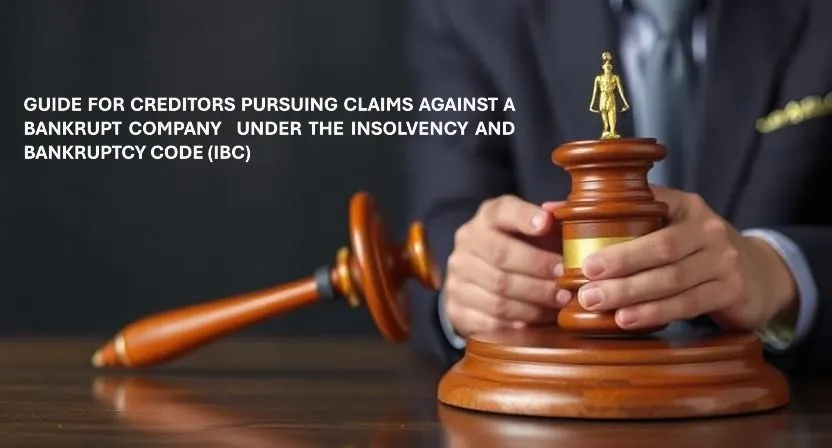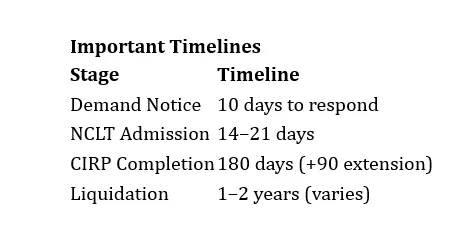
GUIDE FOR CREDITORS PURSUING CLAIMS AGAINST A BANKRUPT COMPANY UNDER THE INSOLVENCY AND BANKRUPTCY CODE (IBC)
This guide outlines the legal framework, procedural steps, and strategic considerations for creditors seeking to recover dues from a bankrupt company in India under the Insolvency and Bankruptcy Code (IBC), 2016. The IBC prioritizes creditor rights and streamlines insolvency resolution through a time-bound process.
OVERVIEW OF THE IBC FRAMEWORK
The IBC aims to resolve insolvency in a creditor-friendly manner by:
1. Providing a structured mechanism for debt recovery.
2. Ensuring fair distribution of assets in liquidation.
3. Promoting revival of distressed companies through resolution plans.
4. Imposing strict timelines (max 180+90 days for CIRP).
Key Authorities Involved:
• National Company Law Tribunal (NCLT): Admits insolvency petitions and oversees proceedings.
• Insolvency Resolution Professional (IRP): Manages the Corporate Insolvency Resolution Process (CIRP).
• Committee of Creditors (CoC): Decides the fate of the company (resolution or liquidation).
• Insolvency and Bankruptcy Board of India (IBBI): Regulates IRPs and ensures compliance.
KEY STEPS FOR CREDITORS TO INITIATE AND NAVIGATE THE CIRP
1. Pre-Petition Requirements
a. Demand Notice (Section 8 of IBC):
• Who Can Send? Financial creditors (e.g., banks, NBFCs) must issue a demand notice to the corporate debtor. Operational creditors (e.g., suppliers) must send a demand notice and a copy of an unpaid invoice.
• Content: Clearly state the default amount, details of the debt, and demand repayment within 10 days.
• Proof: Retain evidence of delivery (e.g., registered post, email acknowledgment).
b. Filing the Insolvency Petition (Section 7/9 of IBC):
• Threshold: Financial creditors require a default of ₹1 crore or more (reduced from ₹2 crore in 2020). Operational creditors must prove default and lack of dispute.
• Documents Required:
‣ Proof of debt (loan agreements, invoices, ledgers).
‣ Evidence of default (bank statements, bounced checks).
‣ Copy of demand notice and proof of delivery.
2. Admission of Petition by NCLT
• Timeline: NCLT must decide on admission within 14 days (extendable to 21 days).
• Outcomes:
‣ If admitted:
⁃ Moratorium is imposed (no legal actions against the company).
⁃ IRP is appointed to take over management.
‣ If rejected: Creditor may appeal to NCLAT.
Critical Tip: Ensure all documentation is airtight to avoid dismissal. Engage legal counsel to draft the petition.
3. Corporate Insolvency Resolution Process (CIRP)
a. Role of the IRP
• Public Announcement: IRP invites claims from all creditors within 14 days.
• Verification of Claims: Creditors must submit claims with proof (e.g., loan agreements, invoices).
• Constitution of CoC:
⁃ Only financial creditors are part of the CoC.
⁃ Voting share is proportional to the debt amount.
b. Strategic Participation in the CoC
• Voting Rights: Secured creditors (e.g., banks) hold majority voting power. Operational creditors are not part of CoC but can attend meetings.
• Key Decisions:
‣ Approval of resolution plans (requires 66% majority).
‣ Replacement of IRP.
‣ Extension of CIRP timeline.
Actionable Advice:
• Collaborate with other creditors to form a voting bloc. • Scrutinize resolution plans for feasibility and fairness.
c. Resolution Plan Submission
• Timeline: Resolution plans must be submitted within 180 days (extendable by 90 days).
• Evaluation Criteria:
‣ Maximizes value for creditors.
‣ Ensures company revival.
‣ Complies with IBC regulations (e.g., no haircuts for operational creditors below liquidation value).
Note: If no plan is approved, NCLT orders liquidation.
4. Liquidation Process
If resolution fails, the company enters liquidation:
1. Liquidator Appointment: The IRP typically becomes the liquidator.
2. Asset Realization:
‣ Secured creditors can enforce security interests or relinquish them to the liquidator for liquidation proceeds.
3. Priority of Payments (Section 53 of IBC):
• Order:
‣ Insolvency resolution and liquidation costs.
‣ Secured creditors (if they relinquish security).
‣ Employee wages (up to 24 months).
‣ Unsecured financial creditors.
‣ Government dues. Shareholders.
Key Insight: Secured creditors recover first, but operational creditors often face lower recovery rates.
STRATEGIC CONSIDERATIONS FOR CREDITORS
1. Avoidable Transactions (Sections 43–66 of IBC)
Creditors can challenge:
• Preferential Transactions: Payments favoring specific creditors within 1 year of insolvency.
• Undervalued Transactions: Asset transfers below market value.
• Fraudulent Transactions: Intentional asset diversion.
Action: File applications with NCLT to claw back such transactions.
2. Monitoring the Process
• Attend CoC meetings regularly.
• Demand transparency from the IRP on asset valuations and resolution plans.
3. Legal Recourse
• Appeal adverse NCLT decisions to the National Company Law Appellate Tribunal (NCLAT).
• Report IRP misconduct to the IBBI.

Challenges and Solutions
Delays in NCLT Proceedings: File interlocutory applications to expedite hearings.
Low Recovery in Liquidation: Prioritize resolution over liquidation by supporting viable plans.
Operational Creditor Exclusion: Negotiate with CoC to ensure fair treatment in resolution plans.
CONCLUSION
The IBC empowers creditors to recover dues efficiently, but success requires:
Proactive Participation: Engage in CoC decisions and monitor IRP actions.
Documentation: Maintain meticulous records of debt and default.
Legal Expertise: Partner with insolvency professionals to navigate complexities.
By leveraging the IBC’s provisions, creditors can maximize recoveries while contributing to India’s evolving insolvency ecosystem.
Key Resources:
• Insolvency and Bankruptcy Code, 2016.
• IBBI Regulations.
• NCLT/NCLAT Case Law Database.
Sign up for my newsletter

